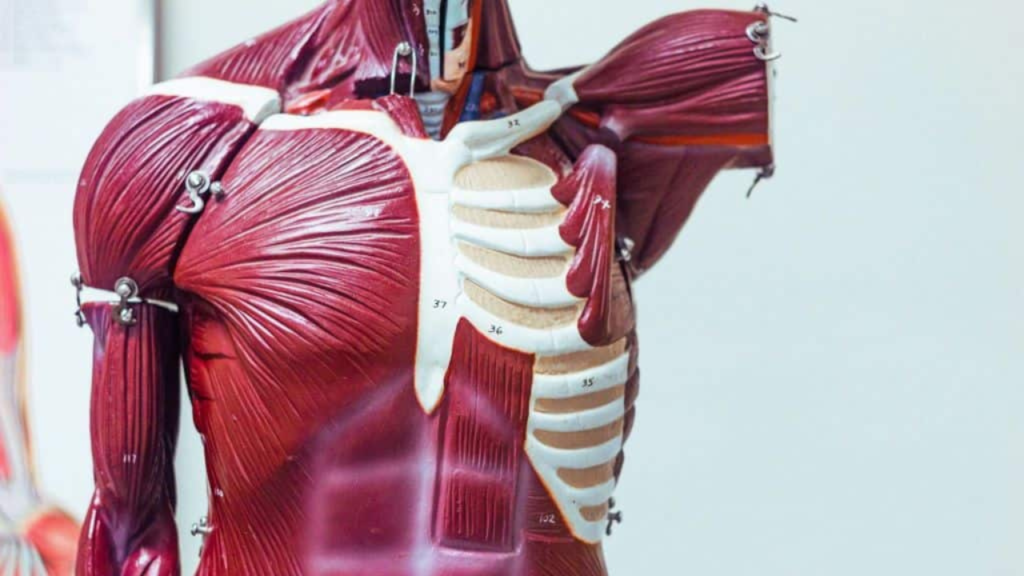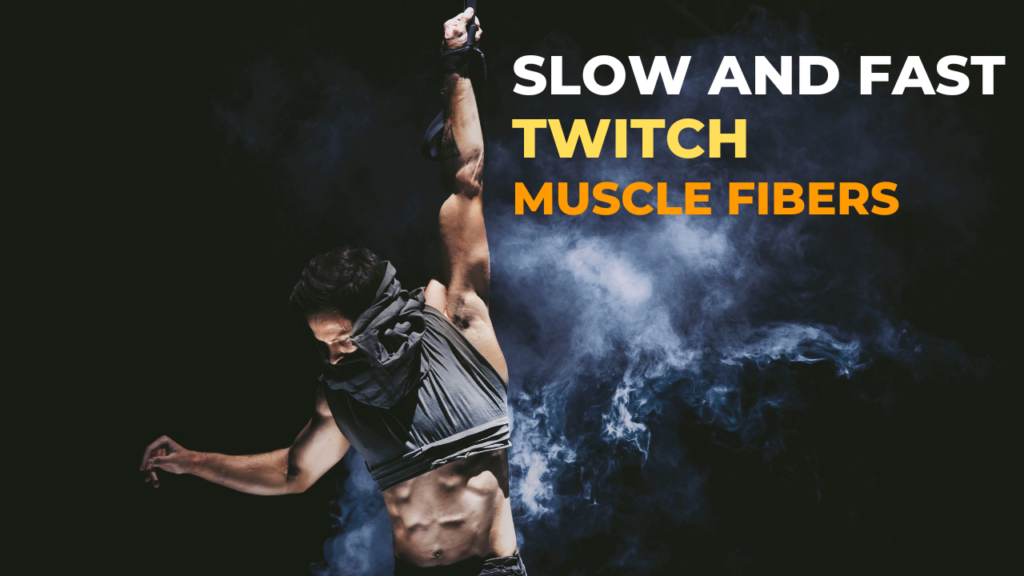If you’ve ever wondered about the difference between slow and fast twitch muscle fibers, you’re not alone. It’s a fact that not many people think about when strength training, that there are actually two different types of muscle tissue: the fast and slow twitch muscle fibers.
In this article, we will discuss the differences between these two types of muscle fibers and how they can affect your performance. We will also provide tips on how to train each type of fiber for optimal results.

Muscles are made of hundreds of thousands of muscle cells. Muscle cells and muscle fibers can be used interchangeably, which we will likely do in this article, so don’t get confused!
Muscle fibers have the amazing ability to contract. This enables us to move our bodies and function in day-to-day life.
In every skeletal muscle in your body, a certain percentage of the muscle fibers will be slow twitch, and another percentage will be fast twitch muscle fibers. On average, people have about 50% slow and 50% fast twitch fibers. There is actually a third type of muscle fiber but it isn’t important for the context of this article so we will be ignoring that.
The difference between fast and slow muscle fibers is slow twitch muscle fibers contract slowly but have good endurance and energy production efficiency. On the other hand, fast twitch muscle fibers contract quickly and rapidly producing more force, but they tire out more quickly and are not as efficient in terms of energy.
Depending on the exercise you are doing, you will be recruiting different percentages of different types of muscle fibers as compared to participating in other activities.
The slow twitch muscle fibers will adapt differently than the fast twitch, and we have some level of control over this depending on the activities, or sports we participate in.
What Are Slow Twitch Muscle Fibers?
Slow twitch muscle fibers are scientifically known as slow oxidative or type 1 fibers. The name slow oxidative describes the amazing aerobic capacity of these muscle fibers.
That’s because they use oxygen to break down carbohydrates and sometimes proteins, in order to synthesize the energy of our cells called adenosine triphosphate (ATP).
Our muscle cells burn through a lot of ATP (energy) when exercising. This is why it is useful for a muscle cell to make high quantities of ATP, which is exactly what slow twitch muscle fibers are set up to do.
There are 3 ways slow twitch muscle fibers are set up to create the maximum amount of energy with the oxygen they’re given:
- Slow twitch fibers have a high number of capillaries which means they have a high blood supply in order to receive a lot of oxygen and nutrients.
- They also have a high number of iron-containing proteins called myoglobin. Myoglobin helps to bind and store oxygen within the muscle fiber so that it can be used to synthesize ATP.
- Slow twitch muscle fibers are also filled with high numbers of mitochondria, which are kind of like little organs within the muscle cells which help create ATP and they use oxygen in order to do that.
Because of their great blood supply, myoglobin content, and the number of mitochondria that they have, these slow twitch fibers are really set up to maximalize their oxygen supply in order to create energy (ATP) to move your body’s muscles.
Why is oxygen so important?
When our cells utilize oxygen to make ATP, they can make about 18x more ATP when using oxygen compared to making ATP without using oxygen. It is roughly the case that with one glucose molecule, we can make 36 ATP with oxygen, but only 2 ATP in situations without oxygen.
Pros and Cons of Slow Twitch Muscle Fibers
As with everything in biology, there are drawbacks that come with the benefits:
Pros
- Slow twitch muscle fibers are far more resistant to fatigue during lower intensity activities such as walking, yoga, light weight training, jogging, or even just standing up all day. This is because the muscles have enough time to synthesize sufficient levels of ATP.
Cons
- Slow twitch muscle fibers tend to be smaller in diameter, and therefore contract with less force.
- They are called slow twitch for a reason, their speed of contraction is generally slow compared to the fast twitch muscle fibers. Part of the reason is the time it takes to make that much ATP, compared to how fast the fast twitch fibers make their ATP.
How Do Slow Twitch Muscle Fibers Adapt to Exercise?
Over time, if you continuously perform exercise which makes use of your slow twitch muscle fibers, they will adapt in the following ways to perform more efficiently:
- The number of capillaries that deliver oxygen and nutrients to the muscle will be increased.
- Myoglobin content can go up, so more oxygen can be bound into ATP (energy).
- Mitochondria can increase in number as well as size so the muscles can process more oxygen.
In a nutshell, all of these things together will mean more muscular endurance.
What Are Fast Twitch Muscle Fibers?
Fast twitch muscle fibers are scientifically known as fast glycolytic or type IIB fibers. To understand fast twitch muscles, we can almost reverse the facts of the slow twitch muscle fibers:
- The fast twitch muscle fibers have fewer capillaries, lower amounts of myoglobin, and fewer mitochondria.
- Fast twitch fibers are not known for their endurance or their ability to resist fatigue.
- Fast twitch fibers are generally larger in diameter, can store more glycogen (which is the storage form of glucose), and can contract with more force and velocity. Hence the name, fast twitch or fast glycolytic.
Fast twitch muscle fibers break down glucose without the use of oxygen, which means they only produce 2 ATP per glucose molecule as mentioned earlier. The benefit of this is it’s faster to convert the glucose to energy but the downside is that lactic acid is the byproduct and it’s less efficient at producing energy than the slow twitch muscle fibers.
A really simple practical demonstration would be if you tried to full-on sprint for as long as you can, you know that you’re not going to be able to do this for as long as you can walk or jog.
How Do Fast Twitch Muscle Fibers Adapt to Exercise?
In order to grow fast twitch muscles, the muscle needs to go through a big enough intensity or a big enough speed. For example, going from a jog to a sprint or going for a big jump. Or of course, lifting heavy weights.
Your muscles adapt to this by undergoing a process called hypertrophy. Hypertrophy causes the muscle fibers that you have to increase in size.
In order for your muscles to increase in size, you need protein to create protein contractile units, and that’s why you may hear a lot of talk about are you getting enough protein in your diet when the topic of strength training comes up.
Muscles with larger cross-sectional areas will produce more force. They can also store more glycogen as an adaptation, therefore you have more glucose stores in there to create more energy (ATP).
RELATED: Pre-workout ingredients that activate fast twitch muscle fibers.
Summary
To bring this all together, these two different muscle types do not exist in isolation. The vast majority of athletic activities or exercises will activate both fast and slow twitch muscle fiber types. Granted, depending on the exercise, you will recruit one more than the other.
As pointed out before, endurance activities will use prominently slow twitch muscle fibers and heavy strength training will use mostly fast twitch muscle fibers.
Any given muscle will have a percentage of slow twitch and a percentage of fast twitch muscle fibers. These percentages can change depending on the lifestyle of the individual.
For example, a marathon runner is going to have a higher percentage of slow twitch muscle fibers than someone who does a lot of weightlifting, and vice-versa.
Sources
- Types of Muscle Fibers – https://opentextbc.ca/anatomyandphysiologyopenstax/chapter/types-of-muscle-fibers/
- Skeletal Muscle Form and Function – https://books.google.co.uk/books?id=-EfxEhSFaMYC
- Skeletal Muscle Fiber Type: Influence on Contractile and Metabolic Properties – https://journals.plos.org/plosbiology/article?id=10.1371/journal.pbio.0020348
- American Council on Exercise – https://www.acefitness.org/resources/pros/expert-articles/5714/muscle-fiber-types-fast-twitch-vs-slow-twitch/
Editor-In-Chief at Recovatech. Dr. Ben is a board-certified Doctor of Chiropractic with over 10 years of clinical experience. He specializes in structural and neurological imbalances with an emphasis on functional movement patterns, exercise performance, and muscle recovery. He has been the team chiropractor for professional baseball and soccer organizations, as well as collegiate athletes. In his personal life, he’s always been driven when it comes to athletics and personal performance.

